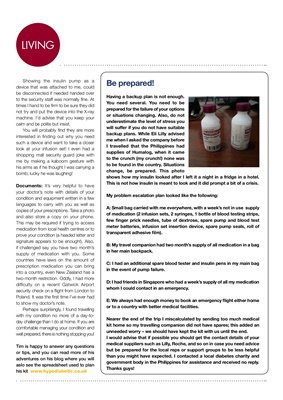
LIVINGLIVING
Showing the insulin pump as a
device that was attached to me, could
be disconnected if needed handed over
to the security staff was normally fine. At
times I hand to be firm to be sure they did
not try and put the device into the X-ray
machine. I'd advise that you keep your
calm and be polite but insist.
You will probably find they are more
interested in finding out why you need
such a device and want to take a closer
look at your infusion set! I even had a
shopping mall security guard joke with
me by making a kaboom gesture with
his arms as if he thought I was carrying a
bomb; lucky he was laughing!
Documents: It's very helpful to have
your doctor's note with details of your
condition and equipment written in a few
languages to carry with you as well as
copies of your prescriptions. Take a photo
and also store a copy on your phone.
This may be required if trying to access
medication from local health centres or to
prove your condition (a headed letter and
signature appears to be enough!). Also,
if challenged say you have two month's
supply of medication with you. Some
countries have laws on the amount of
prescription medication you can bring
into a country, even New Zealand has a
two-month restriction. Oddly, I had more
difficulty on a recent Gatwick Airport
security check on a flight from London to
Poland. It was the first time I've ever had
to show my doctor's note.
Perhaps surprisingly, I found travelling
with my condition no more of a day-today challenge than I do at home. If you are
comfortable managing your condition and
well prepared, there is nothing stopping you!
Tim is happy to answer any questions
or tips, and you can read more of his
adventures on his blog where you will
aslo see the spreadsheet used to plan
his kit www.hypodiabetic.co.uk
Be prepared!
Having a backup plan is not enough.
You need several. You need to be
prepared for the failure of your options
or situations changing. Also, do not
underestimate the level of stress you
will suffer if you do not have suitable
backup plans. While Eli Lilly advised
me when I asked the company before
I travelled that the Philippines had
supplies of Humalog, when it came
to the crunch (my crunch!) none was
to be found in the country. Situations
change, be prepared. This photo
shows how my insulin looked after I left it a night in a fridge in a hotel.
This is not how insulin is meant to look and it did prompt a bit of a crisis.
My problem escalation plan looked like the following:
A: Small bag carried with me everywhere, with a week's not in use supply
of medication (2 infusion sets, 2 syringes, 1 bottle of blood testing strips,
few finger prick needles, tube of dextrose, spare pump and blood test
meter batteries, infusion set insertion device, spare pump seals, roll of
transparent adhesive film).
B: My travel companion had two month's supply of all medication in a bag
in her main backpack.
C: I had an additional spare blood tester and insulin pens in my main bag
in the event of pump failure.
D: I had friends in Singapore who had a week's supply of all my medication
whom I could contact in an emergency.
E: We always had enough money to book an emergency flight either home
or to a country with better medical facilities.
Nearer the end of the trip I miscalculated by sending too much medical
kit home so my travelling companion did not have spares; this added an
unneeded worry - we should have kept the kit with us until the end.
I would advise that if possible you should get the contact details of your
medical suppliers such as Lilly, Roche, and so on in case you need advice
but be prepared for the local reps or support groups to be less helpful
than you might have expected. I contacted a local diabetes charity and
government body in the Philippines for assistance and received no reply.
Thanks guys!